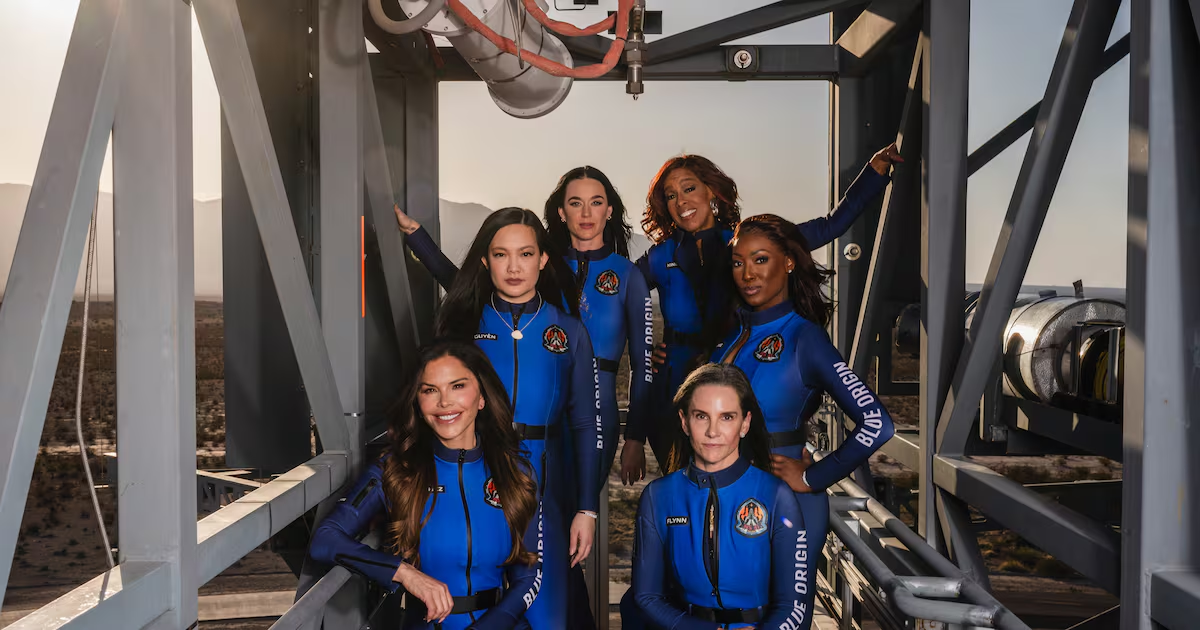When Katy Perry returned from her 11 minute trip to the outer reaches of the earth’s atmosphere this week, she had the breathless enthusiasm of a returning gap year student. “You never know,” she beamed to the cameras, “how loved you are, until the day you launch.” Who could blame her exuberance? Experiencing weightlessness and seeing the planet from so high up sounds exhilarating.
It turns out that a lot of people can blame her. The backlash has been swift and brutal. Much of it focused on the faux feminism in the marketing blitz that surrounded the launch. The flight, which was organised by Jeff Bezos‘s private space travel company Blue Origin, was billed as the first all-female crew to travel to space since 1963.
There were token nods to real feminist concerns in the PR. A team behind the redesigned space suits by Monse, which included designers from Oscar de la Renta, were given a full feature in The New York Times Style section. In remarks that caused widespread hilarity, Perry said she was putting the “ass” in astronaut.
But one of the designers pointed out that he was dealing with “no precedent” for women’s suits, because “all the references are men’s spacesuits”. It’s a point that echoes broader critique by Caroline Criado-Perez and others of male-centred design – from crash test dummies built only to male proportions, to workplace tools and safety gear that overlook women’s bodies.
Yet the designers’ chief concern seemed to be how to bring a “little spice to space”, to create something “flattering and sexy” that would make the women look “very slim”. And in perhaps the perfect metaphor for everything that is wrong with this particular brand of Spice Girls feminism, the design team decided to not include any pockets in the legs of the space suits, because they looked “too bulky”.
[ Katy Perry’s Blue Origin space jaunt is one giant stunt for womankind ]
There were also accusations that the flight was in fact “billionaire SponCon” (sponsored content) designed to pitch commercial space flights. Blue Origin is competing with a number of other private space travel companies – including Elon Musk’s SpaceX – to capture the space travel market, which includes contracts to transport crew and supplies for public missions, as well as tourist space flights that will likely retail for millions of dollars.
As with many 21st century battles, this one is as much one for attention as it is for scientific advancement. Both Blue Origin and SpaceX post bold mission statements focused on how they are “making humanity interplanetary” (SpaceX) and “envisioning a future where millions of people will live and work in space”(Blue Origin). These are truly innovative companies, investing in crucial science that will make space transport more efficient. And space tourism is a fun idea. But it is not space science, the kind of science that helps us understand how our planet functions, how it is warming, where we fit in the universe.
Just as surface-level feminist speak is not a replacement for addressing entrenched gender inequality, privatised space travel is not a replacement for the kind of space science that public institutions like Nasa and the European Space Agency do.
The Blue Origin flight this week was spectacle disguised as progress, inclusion and ambition slimmed down and squeezed into a sexy space suit
Yet public institutions are being stripped of the resources they need to do meaningful work. Nasa had an amazing female scientist – Dr Katherine Calvin, a climate scientist researching how to mitigate the worst of climate chaos – working as its chief scientist, until she was removed by the Trump administration last month. And she will not be replaced. The entire office of chief scientist has been eliminated, and it is likely to lose at least half of its science budget, while government contracts to private space travel companies increase.
Space tourism is to space science what snorkelling is to deep sea marine biology. So it was appropriate that the PR machine behind this week’s launch attempted to skim over the quiet replacement of science critical to understanding our planet with excursions for the ultra-wealthy. And it used its shallow feminism to try to style it out.
[ Meet the Irish women aiming to become space trailblazers ]
It turns out that the use of women for optics around space flight is not new. The precedent cited for this flight was the 1963 flight of Soviet cosmonaut Valentina Tereshkova, the first woman in space. Tereshkova spent three days in orbit, alone, circling Earth 48 times. But her mission was less about scientific advancement and more about cold war optics. The USSR wanted to beat the United States in sending a woman to space, and Tereshkova, who was a factory worker and daughter of a collective farm labourer, fit the image. Her personal story appealed to Soviet leader Nikita Khrushchev, and her boss famously described her as “Gagarin in a skirt.”
This was of course deeply patronising, and presented an idea of women in space not as scientists or explorers, but as salvos in a testosterone-fuelled star wars. Sixty years later, we might be left wondering how much has changed. The Blue Origin flight this week was spectacle disguised as progress, inclusion and ambition slimmed down and squeezed into a sexy space suit. In a time of climate crisis, with state institutions being eroded of their resources and power, the first all-female space flight in 60 years could have been so much more than a joyride in designer suits with no pockets.
Liz Carolan works on democracy and technology issues, and writes at TheBriefing.ie



